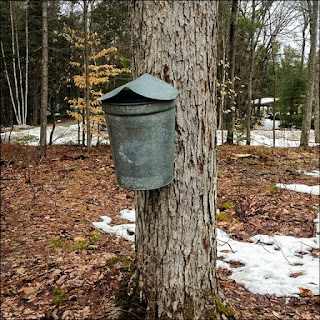Every year, as the winter's landscape begins to
thaw, the maple sugaring season begins. New York State, with the Sugar Maple as
its official state tree, is the second largest producer in the United States,
and the Adirondacks produce almost one third of New York's total production.
However, as the climate continues to change, the consequences are shown in the
Sugar Maple trees. Although maple syrup production plays a major role in
the Adirondacks' culture and history, the warming climate, acid rain, and demanding
production process may force maple syrup production to decline in the future,
impacting the Adirondacks both socially and culturally.
 |
| http://www.adirondackvic.org/Trees-of-the-Adirondacks-Sugar-Maple-Acer-saccharum.html |
The warming climate has affected
many of the trees in the Adirondacks, and will continue affecting the forests
in the future. Maple sugar production is based on sapflow caused by positive
internal pressures, which are mostly a physically process “caused by expansion
of gas compressed in air-filled cells during the freezing process and stabilization
of the compressed gas by osmotic pressures due to accumulation of sucrose in
xylem.” Because sapflow is largely based on the physical relations between
temperature and internal pressure, a warming climate has a strong influence on
sap production. Sap will run if there numerous nights in a row that are below freezing with days above 40 degrees. With warm weather, there may not be nights below freezing. The maple syrup production is highly dependent on climate conditions, and under the shifting climate, maple syrup may become permanently altered.
In addition to the warming climate impacting the
sugar maple trees, acid rain is a major threat to the trees. Recently,
the decline of the Sugar Maple tree populations in the Adirondacks has been
observed by the State University of New York of Environmental Science and
Forestry. There has been a negative growth trend of sugar maples, referred to
as decline disease. There has been branch dieback, foliar discoloration, poor
tissue nutrition, regeneration failure, and elevated mortality. One potential
reason for the decline in sugar maples is the lasting effects of the acid rain
that the Adirondacks faced in the past. According to Jenkins, the Adirondack
region was "one of the most heavily affected regions in the United
States." In the 1960's, as a result of the acid rain caused by Midwestern
factory emissions, the soil was at a maximum pH of 4.0. Since the reduction of
sulfur emissions, the soil has become less acidic at pH levels of .2-.3.
Clearly, acid rain leads to the acidification of soil, which can have
detrimental effects on the surrounding ecosystems. Acid rain alters the
chemistry of the soil, leading to a loss of calcium and increased aluminium.
Changing levels of calcium can lead to alterations of photosynthesis, growth,
and shade tolerance. High levels of aluminium can become toxic and kill the
tree or reduce intake of calcium.
Not only are current environmental factors impacting the trees, the production process itself for maple syrup is extremely
demanding. The fresh sap flowing out of mape trees usually contains about 2%
sugar and finished maple syrup contains about 66-67% sugar. Consequently, it takes
more than 40 gallons of sap from a sugar maple tree to make one gallon of pure
maple syrup. Many gallons of water have to be removed from the sap to produce
maple syrup. Sap from Red and Silver Maple trees can be used to make maple
syrup, however, these trees have even higher water-to-sugar ratios.
Looking into the future, it will be interesting to see the
levels of production of maple syrup in the Adirondacks. Currently, maple syrup
and the production of it are important to the culture and economy of the park. Historically,
Native Americans and early European settlers produced the syrup. And today, it is
still equally as important. Every year, there are weekend festivals dedicated
to maple syrup production. For the
festivals, producers open up their sugarhouses for free tours, tastings, and
demonstrations. The changing climate, environmental pollution, and demanding production process may lead to a future with less maple syrup.
Sources:
http://www.adirondackvic.org/Trees-of-the-Adirondacks-Sugar-Maple-Acer-saccharum.html
Cool post! My mom taps maple trees with her students, and with the weather acting the way it has been, they may start their collection within the next week/week and a half! The process of boiling down the sugar-water takes forever. With a large boiling machine, their boils in the past years have taken usually one full day (dawn to 11pm) for just a few liters of syrup. Additionally, I wonder how climate change may impact the fake-syrup business and thus the resulting corn syrup industry.
ReplyDelete